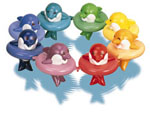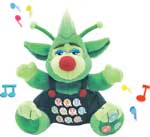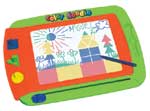|
|||
| Introduction | |||
| Childhood games and toys | |||
| TOYS AND THE FORMATION OF THE PERSONALITY
If toys are so important for the physical and psychological development of children, it is obvious that their elaboration should be closely linked to the successive stages of the formation of their personality, since each period has its own needs and motivations. It is necessary to know them well in order to know where to focus the stimulation. In this sense, there is a correlation between the use that the boy or the girl gives to the toy and the particularities of the development of personality in that specific period. This way, a good toy can be used in the successive stages of the life, because what changes is the way in which children uses it in different ages. The same object-toy can be used during a lot of time, but the game will be more and more complicated, so as to imply continuous stimulation, new elements that force the child to exercise his/her imagination and originality. When inserting the toy in a more and more complex game activity, the same object requires new psychological actions; this allows it to maintain the stimulation level and to continue exercising an effect on the psychological processes and properties, and be present successively in the different phases of the development of the childís personality. Let us use as an example the game of blocks, commonly used in the stimulation of sensory development:
As it is observed, the game has been the same one the whole time, but its use has varied as time goes by and there has been a transformation of the psychological processes of the child. This is also related with the different periods of the formation of his/her personality as the child changes his needs and reasons, and consequently, his actions, interests and forms of behaviour. This way, the use of the toy maintains a correspondence with the emergence and progressive subordination of the motivations that are a basic component in the development of the personality in the first ages. But also, when children use a toy they have positive or negative experiences related to the success or failure of their actions with them, what causes an effect in their emotions and feelings, in the affective-motivational sphere. This affective necessity to be able to establish an emotional relationship with the objects of the world that surrounds them is materialised in toys, and other objects, determining that when children donít have the possibility of establishing this affective contact with such objects, because they donít have them, they substitute them for whatever they have available and they give them the role of toys: a bottle becomes a doll, a wooden piece becomes a ship, a broom becomes a horse... This substitution also has an explanation in the intellectual plane and it is an important component in the game; it also has a very important affective implication, and it will have considerable effects on children as persons.
For this reason it is very important that toys are adapted to the different age levels and infantile interests. In general, attention is paid to the development of the game, while the nature of the objects that intervene in this game receives secondary consideration. However, the boy and the girl invariably conceive the toy from a utilitarian point of view, so that they use it in their games, and the more uses they can conceive for it, the more they will prefer it and the more time they will be interested in it. The best toy is the one that is attuned to the childrenís psychological and physical development, and the one that satisfies the needs and reasons of their personality under formation. For this, it is necessary to have a deep knowledge of the particularities of child development to be able to create toys that truly contribute to this development. Although it is true that toys should be conceived in connection with the age of the users, and therefore, adapted to the current state of development of the children, it is important also to involve children with some others that are somewhat ahead of their possibilities, to influence their potential development, and to stimulate them to reach a higher level of development. This concept has particular significance for the teaching process, it is also important as a means of development of children.
Children must find new forms of action in the same objects and toys, but the adult must elaborate others to help them to use all their potential physical and mental resources. No object in itself motivates children to act, the adult's participation is required to put children in contact with this "world of objects", to teach them the ways of performance historically conceived for these objects. It is good to remember that the toy doesn't teach to play, the same way that no object demonstrates by itself its function, so it is necessary to combine the activities of children and adults so that the small ones assimilate the relationships and functions that are intrinsic to the structure of the object. In this combined activity the adult, when locating some toys that are ahead of the current level of the child's development, stimulates the areas of potential development, and a higher level of development level is obtained as a result. Then, the children will apply by themselves the acquired knowledge, will generalise relationships, and will discover from their own action new means and ways of performance with their toys, in an uninterrupted process of growth and development. |
||||||||||||||||||




